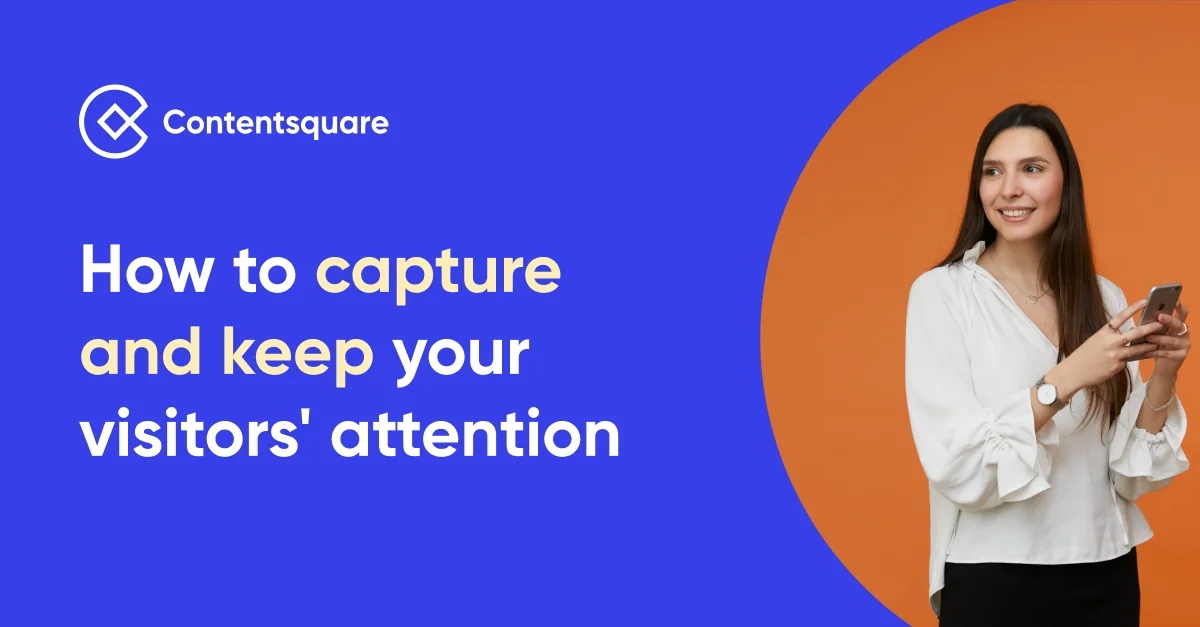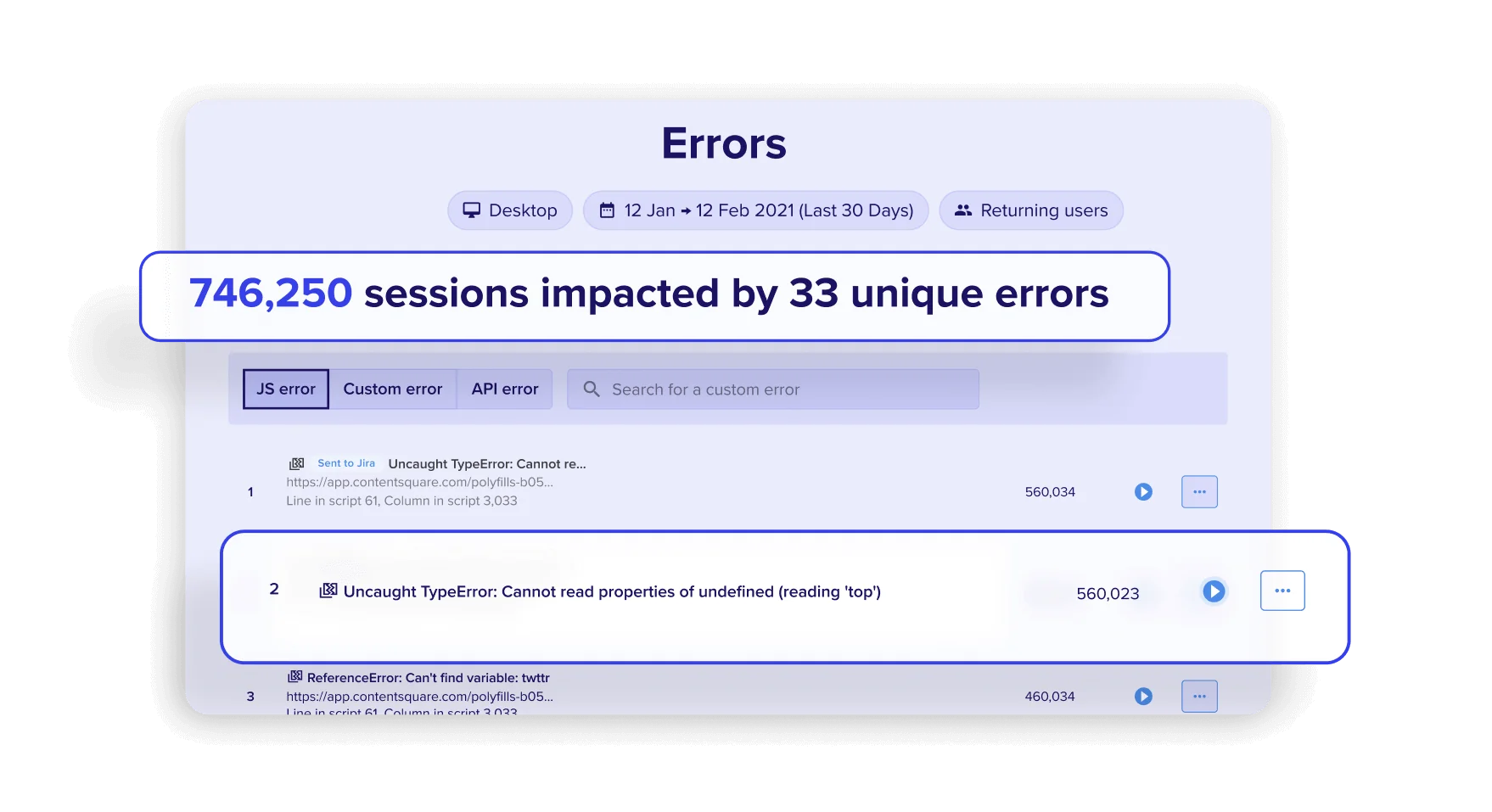
See how your digital experience stacks up.
Get the 2024 Digital Experience Benchmark Report and Interactive Explorer for the metrics that really matter.

The first time someone visits your site, they should have a seamless and satisfying customer experience.
In 2023, we saw a -3.6% drop in web traffic, while the cost to attract each visitor shot up by +9.4%. With website visits at an all-time low (as reported in our 2024 Digital Experience Benchmark Report), it’s crucial to deliver the right content to capture interest and encourage visitors to stick around.
The very first interaction with a website sets the tone for the entire customer journey, and a poor experience can mean a lost sale or conversion opportunity.
See how your digital experience stacks up. Get the 2024 Digital Experience Benchmark Report and Interactive Explorer for the metrics that really matter.
To provide actionable tips on this topic, we’ve leveraged insights from the experts. Gabrielle Schneider (Senior Solutions Consultant at Contentsquare) and Shirly Manor (Solution Engineer at Cloudinary) recently shared their knowledge during the first instalment of the Make the conversion: Identify and eliminate pain points throughout the customer journey webinar series.
Here’s a breakdown:
The awareness stage marks the beginning of a potential customer‘s journey with your brand. It’s where they first encounter your company, perhaps through social media, a search engine, or even a physical store.
At this point, they’re primarily looking for your website to answer the following questions:
First impressions matter; studies show that nearly two-thirds of users know instantly if your site has the answer. A visually appealing, user-friendly site can create a positive impression and encourage visitors to stay longer.
Building trust is also essential at this stage of the buying process, as visitors need to feel confident that your brand is reputable and that they can rely on your products or services. Engaging content and a smooth user experience can keep visitors on your site longer, increasing the chances of conversion.
Results from a 2024 video marketing survey and page speed report reveals a startling truth: 45.4% of shoppers are less likely to make a purchase when the page load time exceeds four seconds. Conversely, 89% of are more likely to purchase after watching a video. This highlights the delicate balance brands need to strike. They must use visually engaging media to capture attention but also ensure the page loads quickly.
Our data further underscores this point. Their research shows that 15.7% of visitors experienced slow page loads in 2023, and websites with poor LCP (Largest Contentful Paint) saw a +3.9% increase in bounce rates. These figures emphasize the importance of a fast-loading, easy-to-use website. Every interaction with a potential customer is precious, so every moment counts.
By applying the “peak-end rule” to website design, brands can use the power of first impressions. People tend to remember the beginning and end of an experience most vividly. A slow-loading, confusing website creates a negative first impression that can be difficult to overcome. On the other hand, a quick, visually engaging website sets the stage for a positive customer journey.
Understanding the challenges users face during the awareness stage is key to crafting an optimized experience.
Gabrielle points out that one of the biggest pain points in the awareness stage is the inability to find necessary information, which can be exacerbated by confusing navigation and slow load times. This frustration can deter potential customers from continuing their journey with your brand.
“If I visit a site and the dropdown menus are confusing and I can’t find the product or section I’m looking for, it’s one thing, but if I can’t find what I am looking for and it’s taking forever to load, my frustration level just increases,” says Gabrielle.
Shirly offers two main issues that you should pay close attention to:
So, how can you address these pain points and ensure a smooth transition for visitors into the next stage of the customer journey? Here are some actionable tips to help you:
Gabrielle suggests that the first step to solving these pain points is to understand where frustrations occur within the user experience. Once identified, addressing the root cause is essential for improvement. “The first step is understanding where those frustrations are occurring within the experience and then getting to the root cause of why,” she advises.
Tools like Contentsquare help you better understand your target audience and identify areas where visitors experience frustration and pinpoint the exact moments they drop off your site. By understanding these pain points, you can take targeted actions to keep visitors engaged and eventually increase conversion rates.

Contentsquare’s Digital Experience Monitoring Error Analysis helps you surface errors on your app or site.
Visual content plays a significant role in user engagement, but it can also slow down your site if not optimized properly. Shirly advises improving images and videos to reduce load times and enhance interactivity.
Using automated tools for template creation can streamline the process and allow marketers to focus on more strategic tasks. “Automate your work by using templates and use more interactive assets such as videos and 3D,” recommends Shirly. Use tools like Cloudinary to enhance your images and videos for faster loading times without sacrificing quality. Automated workflows can streamline this process, ensuring your site looks good and performs well.
A user-friendly website is key to retaining visitors. Ensure your site is easy to navigate and that users can find the information they need quickly. Conduct regular user testing to identify any usability issues and fix them right away. Taking a proactive approach can prevent frustration and keep users on your site longer.

Contentsquare’s Customer Journey Analysis allows you to see how users progress through your site, page by page, from entry to exit
Using tools like Cloudinary and Contentsquare together can address many of the pain points discussed. Cloudinary acts as the engine that optimizes the visual content that fuels engagement, while Contentsquare delves into the human side of the equation – user behavior.
The true magic lies in how Cloudinary and Contentsquare integrate seamlessly.
Picture the following scenario: Contentsquare data reveals that a significant number of visitors are bouncing off the product page due to slow loading times. By drilling down into the data, it can pinpoint the specific images or videos that are causing the slowdown. This information is then fed directly into Cloudinary. Cloudinary can then automatically optimize those specific assets, ensuring faster loading times on the product page.
This is just one example of how these two platforms work together to create a feedback loop that continuously improves the user experience. By combining Cloudinary’s visual performance expertise with Contentsquare’s user behavior insights, brands can create an awareness stage that is not only visually captivating but also frustration-free, ultimately converting more visitors into loyal customers.
With web traffic declining and the cost of attracting visitors rising, optimizing the awareness stage of the customer journey is more critical than ever. By understanding common pain points and leveraging the right tools, you can create a seamless, engaging, and fast-loading website experience that captures and retains visitors.
For more in-depth insights, consider watching the Make the conversion: Identify and eliminate pain points throughout the customer journey webinar series. This five-part series, brought to you by Contentsquare in partnership with Amazon Web Services (AWS), explores the different stages of the customer journey and offers practical advice on identifying and eliminating pain points.
This session is now available to watch On Demand.
Customer journey mapping requires you to consider the following:
– The awareness stage: this is where you capture (and keep) your visitors’ attention
– The consideration stage: at this stage of the buyer journey, you need to prove your value to prospective customers
– The decision stage: during this critical customer touchpoint, you need to convince prospects to make their purchase decision
– The retention stage: your goal at this stage is to keep customer satisfaction high and encourage repeat purchases
– The advocacy stage: at the last customer journey stage, you take advantage of your top existing customers’ loyalty to recruit new customers
The awareness stage is the first step potential customers take in their customer journey. As they’re only becoming aware of your brand and associated products and/or services, your goal is to capture their attention to show them your brand is trustworthy and that your product or service can help solve their pain point, so they move on to the next stage of the journey.
Depending on your marketing efforts, prospective customers may become aware of your brand in a variety of ways. Let’s imagine you’re running an e-commerce store that specializes in selling shoes.
– SEO: You’ve invested in content marketing and created quality long-form content for vegan running shoes. People might google ‘What are vegan running shoes made of?’ and come across one of your website pages on the topic.
– Word-of-mouth: Someone looking for vegan running shoes is talking with a friend of theirs, who just happened to have bought a pair on your website a month ago, is very happy with them, and now recommends your brand (note that this illustrates the power of customer loyalty – more on that when we tackle the advocacy stage).
– Social media: Your performance Marketing team is running ads on social media platforms to audiences interested in running and who follow animal protection pages.
Those are only a few of the many ways a potential customer can become aware of your brand and/or product.